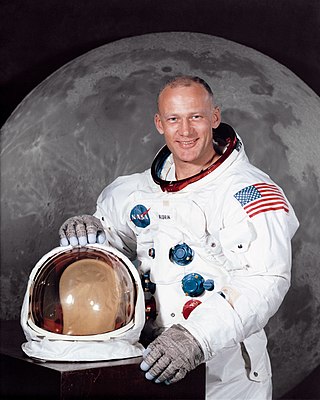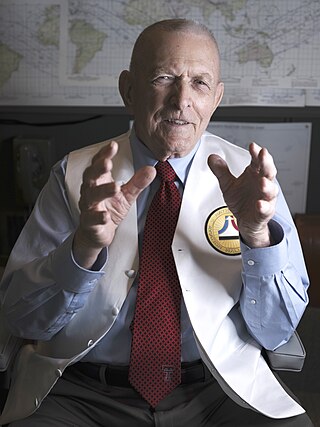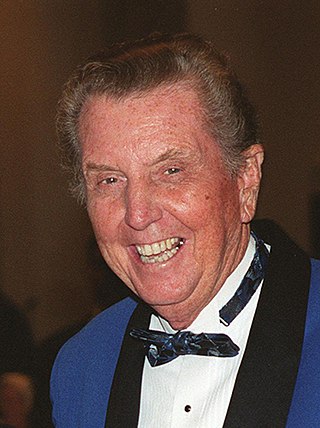
Apollo 11 was the American spaceflight that first landed humans on the Moon. Commander Neil Armstrong and lunar module pilot Buzz Aldrin landed the Apollo Lunar Module Eagle on July 20, 1969, at 20:17 UTC, and Armstrong became the first person to step onto the Moon's surface six hours and 39 minutes later, on July 21 at 02:56 UTC. Aldrin joined him 19 minutes later, and they spent about two and a quarter hours together exploring the site they had named Tranquility Base upon landing. Armstrong and Aldrin collected 47.5 pounds (21.5 kg) of lunar material to bring back to Earth as pilot Michael Collins flew the Command Module Columbia in lunar orbit, and were on the Moon's surface for 21 hours, 36 minutes before lifting off to rejoin Columbia.

Apollo 13 was the seventh crewed mission in the Apollo space program and the third meant to land on the Moon. The craft was launched from Kennedy Space Center on April 11, 1970, but the lunar landing was aborted after an oxygen tank in the service module (SM) failed two days into the mission. The crew instead looped around the Moon in a circumlunar trajectory and returned safely to Earth on April 17. The mission was commanded by Jim Lovell, with Jack Swigert as command module (CM) pilot and Fred Haise as Lunar Module (LM) pilot. Swigert was a late replacement for Ken Mattingly, who was grounded after exposure to rubella.

Apollo 7 was the first crewed flight in NASA's Apollo program, and saw the resumption of human spaceflight by the agency after the fire that had killed the three Apollo 1 astronauts during a launch rehearsal test on January 27, 1967. The Apollo 7 crew was commanded by Walter M. Schirra, with command module pilot Donn F. Eisele and lunar module pilot R. Walter Cunningham.

Buzz Aldrin is an American former astronaut, engineer and fighter pilot. He made three spacewalks as pilot of the 1966 Gemini 12 mission. He was the Lunar Module Eagle pilot on the 1969 Apollo 11 mission and became the second person to walk on the Moon after mission commander Neil Armstrong.

Moon landing conspiracy theories claim that some or all elements of the Apollo program and the associated Moon landings were hoaxes staged by NASA, possibly with the aid of other organizations. The most notable claim is that the six crewed landings (1969–1972) were faked and that twelve Apollo astronauts did not actually walk on the Moon. Various groups and individuals have made claims since the mid-1970s that NASA and others knowingly misled the public into believing the landings happened, by manufacturing, tampering with, or destroying evidence including photos, telemetry tapes, radio and TV transmissions, and Moon rock samples.
Human spaceflight programs have been conducted, started, or planned by multiple countries and companies. The age of manned rocket flight was initiated by Fritz von Opel who piloted the world's first rocket-propelled flight on 30 September 1929. All space flights depend on rocket technology; von Opel was the co-designer and financier of the visionary project. Until the 21st century, human spaceflight programs were sponsored exclusively by governments, through either the military or civilian space agencies. With the launch of the privately funded SpaceShipOne in 2004, a new category of human spaceflight programs – commercial human spaceflight – arrived. By the end of 2022, three countries and one private company (SpaceX) had successfully launched humans to Earth orbit, and two private companies had launched humans on a suborbital trajectory. The criteria for what constitutes human spaceflight vary. The Fédération Aéronautique Internationale defines spaceflight as any flight over 100 kilometers (62 mi). In the United States professional, military, and commercial astronauts who travel above an altitude of 80 kilometers (50 mi) are awarded the United States Astronaut Badge. This article follows the FAI definition of spaceflight.

Edgar Dean Mitchell was a United States Navy officer and aviator, test pilot, aeronautical engineer, ufologist, and NASA astronaut. As the Lunar Module Pilot of Apollo 14 in 1971 he spent nine hours working on the lunar surface in the Fra Mauro Highlands region, and was the sixth person to walk on the Moon.

Fred Wallace Haise Jr. is an American former NASA astronaut, engineer, fighter pilot with the U.S. Marine Corps and U.S. Air Force, and a test pilot. He is one of 24 people to have flown to the Moon, having flown as Lunar Module Pilot on Apollo 13. He was slated to become the 6th person to walk on the Moon, but the Apollo 13 landing mission was aborted en route.

Dennis Anthony Tito is an American engineer and entrepreneur. In mid-2001, he became the first space tourist to fund his own trip into space, when he spent nearly eight days in orbit as a crew member of ISS EP-1, a visiting mission to the International Space Station. This mission was launched by the spacecraft Soyuz TM-32, and was landed by Soyuz TM-31.

Eugene Francis "Gene" Kranz is an American aerospace engineer who served as NASA's second Chief Flight Director, directing missions of the Mercury, Gemini and Apollo programs, including the first lunar landing mission, Apollo 11. He directed the successful efforts by the Mission Control team to save the crew of Apollo 13, and was later portrayed in the major motion picture of the same name by actor Ed Harris. He characteristically wore a close-cut flattop hairstyle and the dapper "mission" vests (waistcoats) of different styles and materials made by his wife, Marta Kranz, for his Flight Director missions.

Alfred Merrill Worden was an American test pilot, engineer and NASA astronaut who was command module pilot for the Apollo 15 lunar mission in 1971. One of 24 people to have flown to the Moon, he orbited it 74 times in the command module (CM) Endeavour.

Moon Shot: The Inside Story of America's Race to the Moon is a 1994 book written by Mercury Seven astronaut Alan Shepard, with NBC News correspondent Jay Barbree and Associated Press space writer Howard Benedict. Astronaut Donald K. "Deke" Slayton is also listed as an author, although he died before the project was completed and was an author in name only, and astronaut Neil Armstrong wrote the introduction.

Gerald Francis Priestland was a foreign correspondent, presenter and, later, a religious commentator for the BBC.
Christopher Riley is a British writer, broadcaster and film maker specialising in the history of science. He has a PhD from Imperial College, University of London where he pioneered the use of digital elevation models in the study of mountain range geomorphology and evolution. He makes frequent appearances on British television and radio, broadcasting mainly on space flight, astronomy and planetary science and was Visiting Professor of science and media at the University of Lincoln between 2011 and 2021.

George William Samuel Abbey is a former director of the Johnson Space Center (JSC) and Fellow in Space Policy at the Baker Institute of Rice University.

Jay Barbree was an American correspondent for NBC News, focusing on space travel. He was the only journalist to have covered every non-commercial human space mission in the United States, beginning with the first American in space, Alan Shepard aboard Freedom 7 in 1961, continuing through to the last mission of the Space Shuttle, Atlantis's STS-135 mission in July 2011. He was present for all 135 Space Shuttle launches, and every crewed launch for the Mercury, Gemini, and Apollo eras. In all, he witnessed 166 human space launches.

The space policy of the Barack Obama administration was announced by U.S. President Barack Obama on April 15, 2010, at a major space policy speech at Kennedy Space Center. He committed to increasing NASA funding by $6 billion over five years and completing the design of a new heavy-lift launch vehicle by 2015 and to begin construction thereafter. He also predicted a U.S.-crewed orbital Mars mission by the mid-2030s, preceded by the Asteroid Redirect Mission by 2025. In response to concerns over job losses, Obama promised a $40 million effort to help Space Coast workers affected by the cancellation of the Space Shuttle program and Constellation program.
Brian Harvey is a space writer, author and broadcaster who lives in Ireland, Brian Harvey has long written about China's space program as well as the space programs of India and Japan. He has written articles on spaceflight from the 1970s in such magazines as Orbit, Astronomy and Space, Go Taikonauts! and Spaceflight and for newspapers such as the Sunday Press and the Irish Independent. His articles have been published in Astronomy Now, Space Quarterly, Space Policy, ROOM, the Journal of the British Interplanetary Society, Space Chronicle, Zenit and Quest.














